| 10th_annual_utsa_flyer_jaj_revised-2.pdf |
|
Here's a wonderful opportunity to attend a free event that will energize your storytelling talents that you might not have known you had! If you're in the San Antonio area this coming Saturday, please stop by - there's great workshops for everyone! Our youth tellers from Tuscany Heights Elementary and Saint Mary's Hall will be entertaining between workshops. Please spread the word! Oh, teachers - there will be certificates handed out so you can receive credit for 3 hours of training!
0 Comments
I'm currently working in three fourth grade classrooms, modeling the writing process, writing crafts, conventions, and instilling the pure LOVE for writing narratives and expository essays. We had a GREAT day incorporating our storytelling skills during the prewriting stage of our expository essays. The joy of human existance is the ability to share one's ideas, wonders, creations, frustrations, and accomplishments. As kindergarten teachers, we had show and tell. The act of writing is no different. Prewriting is the perfect time to have small groups of students share out their ideas for their essay, including little vinettes of each idea. It's amazing to walk around and hear all of the connections made by the mere fact of a peer stating an experience they once had. Wow, at times during this sharing session, an entire group gets riled up because of a shared experience. They've made spontaneous connections to what one child talked about. That puts a smile on my face. As facilitator, I just have to gently remind these kids to add what they are so excited about onto their own graphic organizer. Prewriting Activity:
1. The students were given the prompt for their expository essay: Write about a place that is important to you. Explain why this place is important using details. 2. We reviewed how important our prewriting ideas are to get down on paper before writing our rough draft so I simply shared on the white board how to make a divide your paper up into 4 quadrants (I drew a vertical line down the middle of the paper and a horizontal line across the paper) 3. The four quadrants were labelled: Rooms in home, far away places, secret places, close by places 4. I modeled what came from my own background experiences (my schema) For example, under "Rooms in home" I wrote Kitchen - baked cooked/brownies with Mom. For "Close by places" I wrote camping at Canyon Lake 5. The kids then were asked to do the same - quiet time - no sharing yet. This is the time for everyone to get into their own world to write down what they know personally - no outside influence yet. 6. Best part - I selected a leader for each group of 4 or 5 students to begin sharing out his/her ideas, including vinettes to go with their ideas. The leader would then choose another person in their group to share out. 7. When connections were made, I reminded the students to write down any additional ideas that came from other students that you too could write about. 8. Hard choices - The students were then asked to star the one favorite place that they knew they could write about in detail adding at least 2 - 3 reasons or major details on why this was a favorite place.  What could be better than one storyteller? Two storytellers telling one story! We had so much fun at our last club meeting, Feb. 13th. A few kids, like the two in my picture, had already teamed up to tell their fable tale of the Lion and the Mouse. The young students that they had performed for certainly took notice and were totally engaged. So, I decided to move the entire club in that direction, just to show them other fun venues of telling stories. One of my favorite, funny to the bone tales I've ever heard is "No News", written and told by Barbara Freeman and Connie Regan-Blake. You can find this story in the following book: Best-Loved Stories Told at the National Storytelling Festival. ACTIVITY: Once we read the bare bones to "No News", the students paired up with their notecards and pencils in hand and went to work on their own versions of "No News." We had 30 minutes to create our first drafts and then met back to share out as many of our tandem tales as possible. Oh my! We laughed so hard at the voices that were used, the expressions on each of their faces, and the circumstances that were set up! Although we are in the developing stages of our tales, I've got to tell you that "No News" motivated these kids to write extraordinary pieces. I can't wait to hear the polished tales in two weeks! I did find a barebones example that another storyteller, Richard Martin, used at this website: http://www.tellatale.eu/tales_no_news.html. Check it out! Here's an exceptional website that will convince you to try tandem telling with your students or try tandem telling with a colleague. Wouldn't the kids go crazy after hearing both of you - the perfect way to model so many aspects of reading prep, practice, team work, and presentation! Site: Storytellers-Developing and Using Tandem Stories and Reader's Theatre  Our San Antonio Storytelling Association meets at the Brookhollow Public Library the first Wednesday of every month from 6:30p.m. - 8:00p.m. We would love to see and hear you, whether you are visiting our festive city or a resident who would enjoy listening to tales told and mini-workshops presented. You may want to try out a story you've been dying to hear feedback on. We welcome each and everyone of you. Please check us out on Facebook for upcoming events, such as the Texas Storytelling Conference being held right here in San Antonio on July 26 - July 30, 2014! Our annual membership fee is $15.00.  The Tejas Storytelling Association is our Texas organization that houses itself in Denton, TX. I always look forward to the Tejas Storytelling Festival each spring, featuring world renown storytellers, regional tellers, and swap tents for anyone who wants to share a story. This year, the Tejas Storytelling Festival will be held March 6 - 9, 2014. I'll be telling a ghost story Thursday night, March 6th. You'll have a chance to hear many tellers but also participate in several workshops for educators and want-to-be storytellers. Annual membership fee is $35.00. You can also keep up with TSA on Facebook.  Our National Storytelling organization is the National Storytelling Network. You can find its very informative blog on Facebook. I LOVE listening to their featured storytellers on their blog. I learn so much by listening to their words, inflections, beginnings, endings, and all in-between. NSN has great links to other sites that will help you out in every realm of storytelling, whether your an educator or a business person. NSN has their storytelling Festival during the fall in Jonesborough, Tennessee. The leaves are all the colors of fall, the town is the oldest in Tennessee with much history to brag about. You can't miss it! NSN also has a summer conference, finding its way throughout the United States. This summer, it will be held in Arizona, July 24 - 27, 2014. I'm hoping I can make it this summer!  Olmos Elementary had a wonderful gathering of students and parents engaged in many reading and writing and storytelling activities. Three of our wonderful storytellers from Tuscany Heights Elementary, along with myself, had so much fun telling to several small groups of students and parents every 10 minutes. We had sweet 3 year olds up to 11 eleven year olds and all were great listeners. It was nice to introduce the magic of telling stories along with the reading of stories to the children and their parents. We encouraged each to bring at least one of our stories home to tell to their brothers and sisters. We hope they did! I can't believe February is already upon us! Our youth storytellers are busy adding details, embellishing, and creating very interesting settings for our tried and true Aesop tales. This a a wonderful opportunity for students of all ages to shine by adding the "guts" to a very short fable. I found this activity in one of my favorite resource books for storytelling club sponsors - Raising Voices: Creating Youth Storytelling Groups and Troupes by Judy Sima and Kevin Cordi
Here's an example of a bare bone Fable: The Crow and the Pitcher A very thirsty crow came upon a tall pitcher that was half full of water. When the crow tried to take a drink, he found that his beak was too short to reach the water. While trying to decide what to do, the crow saw some pebbles lying nearby. He picked up the pebbles and, one by one, dropped the pebbles into the pitcher. Soon the level of the water rose almost to the top, and the crow was able to drink. Activity: I read the above fable to the students, reminding them what the "bare bones" of a story is using those index cards that we jot down the 5 most important parts of our stories. I remind students that our brains naturally want to ask questions when there isn't enough information given out and this story begs for us to ask questions. My first question is why is the crow thirsty? Invite your students to ask more questions and write them all down on a chart, or type them up on the projector from a computer. Once all the questions have been asked, divide your students into smaller groups of 2 - 4 and have each group answer the questions to help form the story. (I put in reminders, such as, "don't forget the setting, characters, and by all means exaggerate! Put in items that belong in that setting) One of our groups placed this crow somewhere in a Texas desert, with only dead trees, bones, and the hot sun shining down on the sand and dirt. The pitcher had turned into a long lost canteen from days gone by with just about 1/4 filled with water. I can't wait to hear how this tale progresses! |
Want to follow my blog? Just fill in your email below and you'll receive new posts!
Archives
June 2018
Categories
All
|












 RSS Feed
RSS Feed